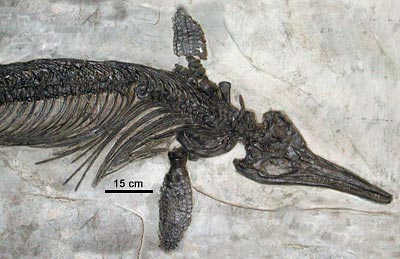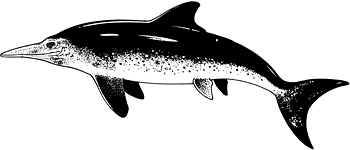Introduction to the Ichthyosauria
 A specimen of the Jurassic icthyosaur Ichthyosaurus intermedius, found in Somerset County, England. Photo by Sara Rieboldt, © UC Museum of Paleontology. |
Some really cool information on ichthyosaurs has been put together by Ryosuke Motani, a former post-doc in Kevin Padian's lab.
While dinosaurs ruled the land, the ichthyosaurs, classified variously in the Ichthyosauria or in the Ichthyopterygia, shared the seas of the world with the other great groups of large marine reptiles, the plesiosaurs and mosasaurs. "Ichthyosaur" means "fish lizard," while "Ichthyopterygia" means "fish paddle." Both names are apt. The earliest ichthyosaurs had long, flexible bodies and probably swam by undulating, like living eels. More advanced ichthyosaurs — like the one shown above, on display at the Senckenberg Museum in Frankfurt, Germany — had compact, very fishlike bodies with crescent-shaped tails. The shape of these ichthyosaurs is like that of living tunas and mackerels, which are the fastest fish in the ocean; like them, the later ichthyosaurs were built for speed. Note the paddles with which ichthyosaurs swam; they have the same basic plan as your hand and arm, but the arm bones are very short, while the fingers have lengthened by developing many more bones than the three that make up each of your fingers.
 Reconstruction of Ichthyosaurus. |
Rare fossils have been found that show ichthyosaurs actually giving birth to live, well-developed young; ichthyosaurs never had to leave the water to lay eggs. In fact, from their streamlined, fishlike bodies, it seems almost certain that ichthyosaurs could not leave the water. Yet they still breathed air and lacked gills, like modern whales.
Ichthyosaurs were not dinosaurs, but represent a separate group of marine vertebrates. Because ichthyosaurs were so specialized and modified for life in the ocean, we don't really know which group of vertebrates were their closest relatives. They might have been an offshoot of the diapsids — the great vertebrate group that includes the dinosaurs and birds, the pterosaurs, the lizards and snakes, and many other vertebrates. On the other hand, some have suggested that the ichthyosaurs were descended from a distant relative of the turtles.
The first ichthyosaurs appeared in the Triassic. In the Jurassic, ichthyosaurs reached their highest diversity, and then began to decline. The last ichthyosaurs disappeared in the Cretaceous — several million years before the last dinosaurs died out. Whatever caused the extinction of the dinosaurs did not cause the ichthyosaurs to die out.
An on-line article by paleontologist Richard Cowen, "Locomotion and respiration in marine air-breathing vertebrates," describes how ichthyosaurs — and many other marine vertebrates — lived and breathed.
Berlin-Ichthyosaur State Park, near Gabbs, Nevada, includes a partial excavation of some of the largest and best-preserved ichthyosaurs anywhere in the world.
Read about the Saurian Expedition of 1905 on which UCMP benefactress Annie Alexander collected many ichthyosaurs.